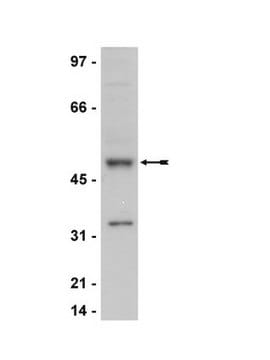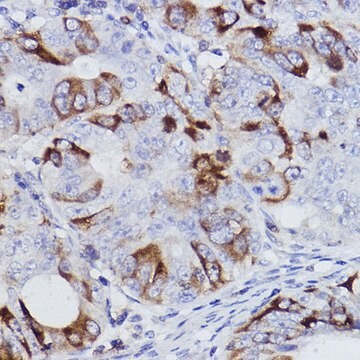05-373
Anti-Cyclin B1 Antibody, clone GNS3 (8A5D12)
clone GNS3 (8A5D12), Upstate®, from mouse
Synonym(s):
G2/mitotic-specific cyclin B1, cyclin B1
About This Item
Recommended Products
biological source
mouse
Quality Level
antibody form
purified antibody
antibody product type
primary antibodies
clone
GNS3 (8A5D12), monoclonal
species reactivity
human, mouse
packaging
antibody small pack of 25 μg
manufacturer/tradename
Upstate®
technique(s)
immunohistochemistry: suitable
immunoprecipitation (IP): suitable
western blot: suitable
isotype
IgG
NCBI accession no.
UniProt accession no.
shipped in
dry ice
target post-translational modification
unmodified
Gene Information
human ... CCNB1(891)
mouse ... Ccnb1(268697)
General description
Specificity
Application
2 μg of a previous lot immunoprecipitated human cyclin B1 and cdc2 kinase from 500 μg of A431 RIPA lysate as determined by a subsequent immunoblot of the immunoprecipitate using anti-cdk1/cdc2 (PSTAIR), (Catalog # 06-923).
Western Blotting Analysis: 0.1 mg/mL of this antibody detected Cyclin B1 in A431 cell lysate.
Immunohistochemistry (Paraffin) Analysis: A 1:250 and 1:50 dilutions of this antibody detected Cyclin B1 in Human tonsil and Human bone marrow tissue sections, respectively.
Quality
Western Blot Analysis:
0.5-2 μg/mL of this lot detected cyclin B1 in RIPA lysates from human A431 carcinoma cells.
Target description
Linkage
Physical form
Analysis Note
Positive Antigen Control: Catalog #12-301, non-stimulated A431 cell lysate. Add 2.5µL of 2-mercaptoethanol/100µL of lysate and boil for 5 minutes to reduce the preparation. Load 20µg of reduced lysate per lane for minigels.
Other Notes
Legal Information
Not finding the right product?
Try our Product Selector Tool.
recommended
Certificates of Analysis (COA)
Search for Certificates of Analysis (COA) by entering the products Lot/Batch Number. Lot and Batch Numbers can be found on a product’s label following the words ‘Lot’ or ‘Batch’.
Already Own This Product?
Find documentation for the products that you have recently purchased in the Document Library.
Our team of scientists has experience in all areas of research including Life Science, Material Science, Chemical Synthesis, Chromatography, Analytical and many others.
Contact Technical Service








